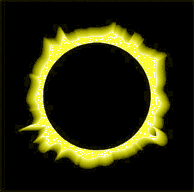HOME > WordMaster® > ECLIPSE (OF THE SUN/MOON) | (日/月)蝕
![]()
2004.06.07
Welcome back for another week of "WordMaster 2004 - A Space Odyssey"! The big event is just a day away! Let's hope for clear skies tomorrow!
Today we talk about another one of nature's grand spectacles!

ECLIPSE (OF THE SUN/MOON) (日/月)蝕
- An eclipse of the sun occurs when the moon passes in front of the sun so that part (a "partial eclipse") or all (a "total eclipse") of the sun cannot be seen for a time.
An eclipse of the moon occurs when the earth moves between the sun and the moon, blocking the sun's light so that part or all of the moon cannot be seen for a time. - eclipse of the sun は、日蝕という意味です。月が太陽の前を通過するため、一時的に、太陽の一部を隠す(部分蝕)または、全部を隠す(皆既蝕)現象です。
eclipse of the moon は、月蝕という意味です。地球が太陽と月の間に入って、太陽の光をさえぎるため、一時的に、月の一部または全部が地球の陰に隠れて見えなくなる現象です。

- You should never look directly at the sun, even during an eclipse.
- Just once before I die, I would like to see a total eclipse of the sun.
- There's going to be an eclipse of the moon tonight!
 Don't miss tomorrow's big show in space!
Don't miss tomorrow's big show in space!
*** PROTECT YOUR EYES! Never look directly at the sun; you can damage your eyes instantly! The safest way to view the transit is to project the sun's image onto a piece of paper using a telescope, binoculars, or pinhole. You can also use #14 welder's glass, two layers of fully-exposed and developed black-and-white (NOT color) negative film (only the kind with a layer of silver in it is considered safe), or other filters specially made for viewing the sun. There are many Web sites describing safe ways to watch eclipses if you'd like more information.

